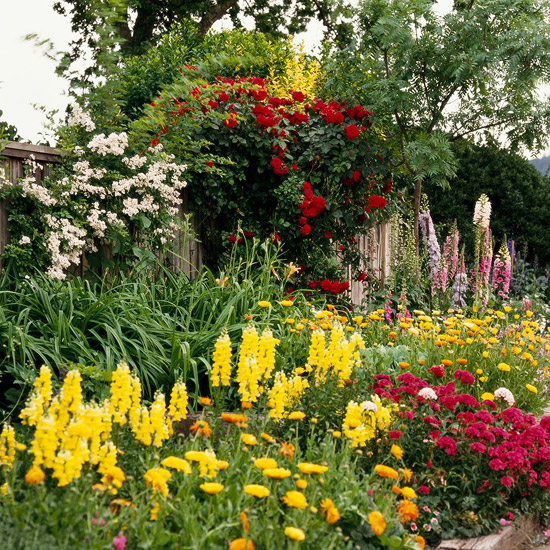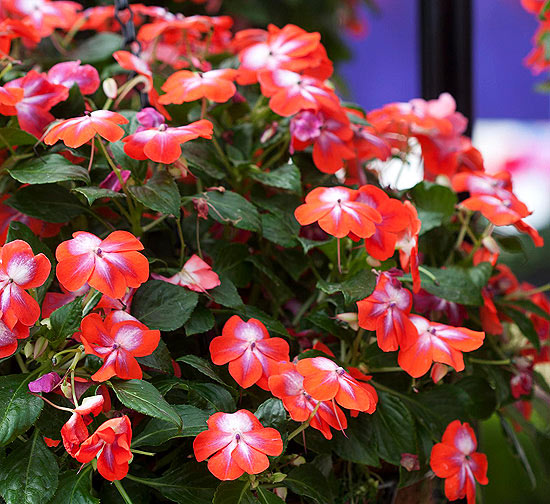





 In any flower combination, choose complementary hues for an eye-pleasing canvas of color.
In any flower combination, choose complementary hues for an eye-pleasing canvas of color.
Large or small, formal or information, bold or subdued -- whatever your landscape style, annuals can fit pleasantly into the plan.
As you design your garden, keep in mind that bright, exciting colors make the garden appear smaller than it actually is. Cool tones, which are more soothing to the eye, will make your garden seem larger. A mixed spring border pops with bright, warm tones of red, yellow, and orange.
If you like a vivid color scheme, try marigolds, salvia, snapdragons, or celosia. For subtler tones, select the blues and violets of pansies, ageratums, or lobelias for a cooler, more tranquil effect.
A mixture of Shirley poppies, annual chrysanthemums, and California poppies gives an informal, country look to a suburban garden. Cosmos and spider flower, with an edging of sweet alyssum, would also look lovely. If you'd like a more formal look, stick with beds of one variety of annual. Good choices include geraniums, marigolds, and petunias. For contrast, add a silvery dusty-miller edging.
Flower beds should be geared to the existing climate and soil conditions. In a dry-soil area, a garden could include statice, ice plant, daisies, portulaca, and California poppies. Sweet alyssum, zinnia, and vinca also do well in dry soil. Adding organic matter prior to planting helps conserve soil moisture in areas where water is scarce.
Cooler, moister annual beds are best planted with flowers such as browallia, lobelia, pansies, and salpiglossis. A mulch helps keep the soil cool and moist all season long.
When selecting annuals for your flower beds, remember that the most interesting combinations come from mixing plant sizes and shapes. For example, tall, spiked African marigolds look good behind bushy plants of cosmos, which taper down to mounds of dahlias or celosia. In the foreground, you can use ground-hugging gazania, annual phlox, dianthus, or verbena.
Flowers and foliage also offer a variety of sizes, shapes, and textures, and are effective when mixed. The daisy-like blossoms of gaillardia, spikes of salvia, and puffs of ageratum go well together. Foliage can be fine-textured, like the leaves on cosmos, or coarse, like those on the sunflower. Consider, too, the silver leaves of dusty-miller, the bronze of some begonias, the patterns of coleus, or the scalloping of nasturtium leaves.
continue reading below
Your garden can have color even if it's shaded by a variety of trees and buildings. A bed of impatiens grows happily in subdued light. Try low-growing types of Super Elfins, Minis, medium-size Cinderella or tall Blitz.
Another good choice for shaded areas is the wax (fibrous) begonia. In climates where high heat and humidity exist, use bronze-leaved wax begonias. Coleus also does well in dark areas. All three of these shade-lovers need a minimum of maintenance after planting -- just water them regularly.
Let your annuals play the roles for which they are best suited. Leading ladies for cool-climate container plants include pansies, dianthus, and Martha Washington geraniums. If you'd like to fill a planter with petunias, one of the large-flowered grandiflora types would be best. But if you want a petunia for a mass effect in a flower bed, select a multiflora type, which is more weather- and disease-resistant, and will produce a greater number of flowers.
If you enjoy bringing the beauty of your garden indoors, plant annuals that make good cut flowers, including aster, celosia, cosmos, dahlia, zinnia, stock, snapdragon, salvia, marigold, and poppy. Select baby's-breath, strawflower, statice, or other everlastings if you plan to dry flowers.
Learn more about drying flowers.
Copyright © www.100flowers.win Botanic Garden All Rights Reserved